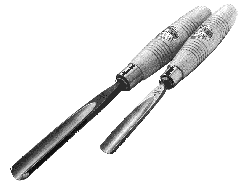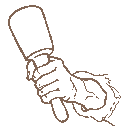

| TAMWORTH & | S t a f f o r d s h i r e | |
| LICHFIELD COLLEGE | U N I V E R S I T Y | |
| Lichfield Campus |
 Carving chisels vary in three main ways :-
Carving chisels vary in three main ways :-
 The other tools that you may find useful, are a selection of knives, if you are to
specialise in chip carving, and various holdfasts, bench screws, cramps and vices for
holding the work down. The mallet, invariably with a round head so that the carver may
strike from any direction without altering his grip on the handle, and about 3/4 pound in
weight for most work. Too heavy and the job gets tiring. A larger mallet is useful for
larger removing larger amounts of wood at the beginning of the job.
The other tools that you may find useful, are a selection of knives, if you are to
specialise in chip carving, and various holdfasts, bench screws, cramps and vices for
holding the work down. The mallet, invariably with a round head so that the carver may
strike from any direction without altering his grip on the handle, and about 3/4 pound in
weight for most work. Too heavy and the job gets tiring. A larger mallet is useful for
larger removing larger amounts of wood at the beginning of the job.
Visit us by E-Mail: woodcarving@ldb.co.uk

